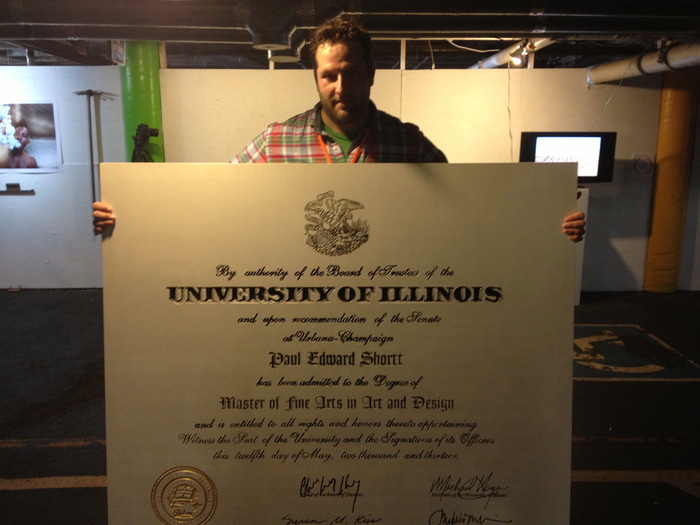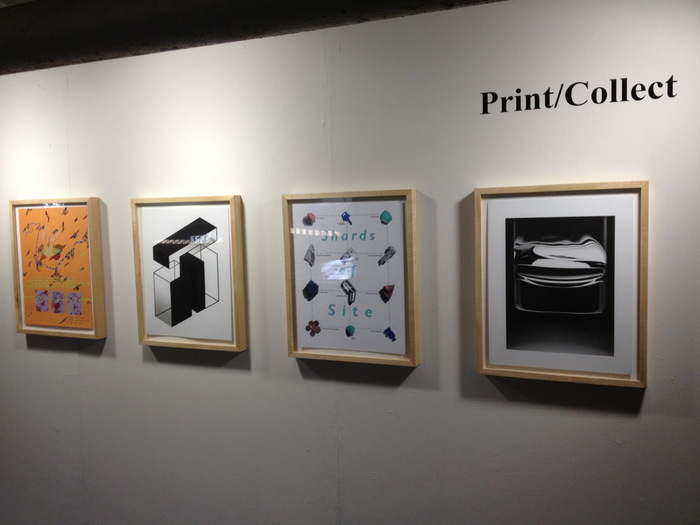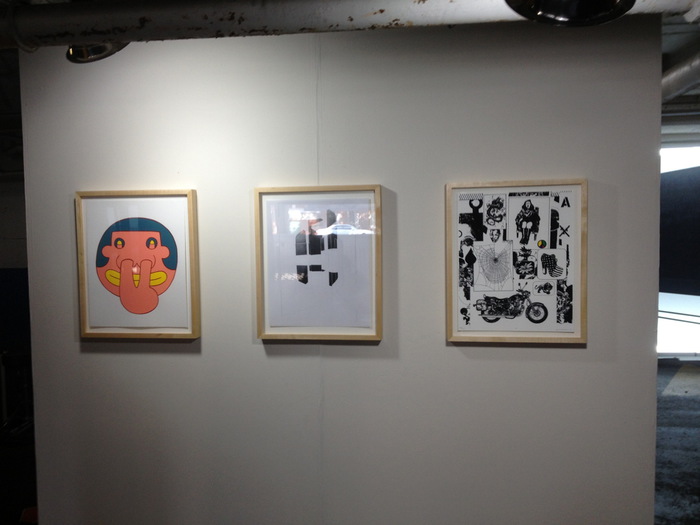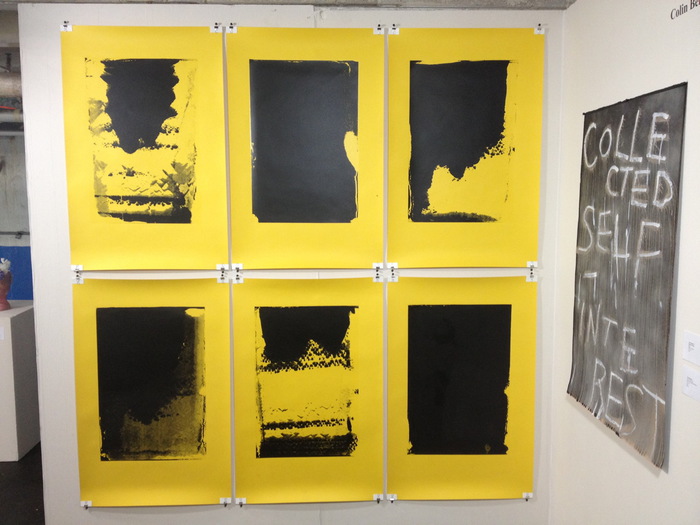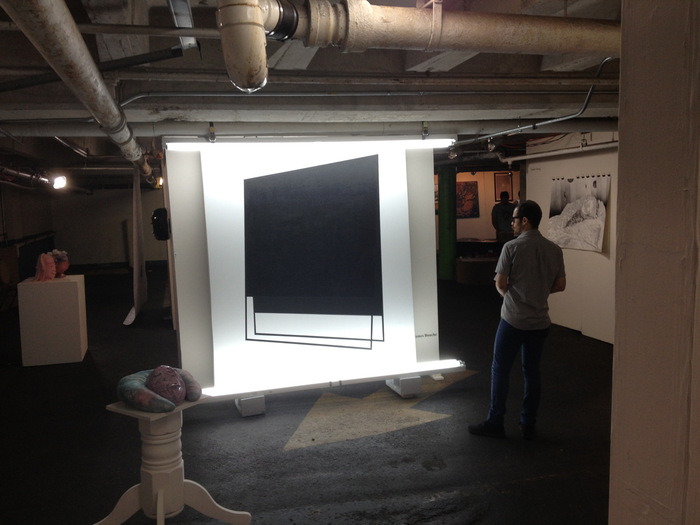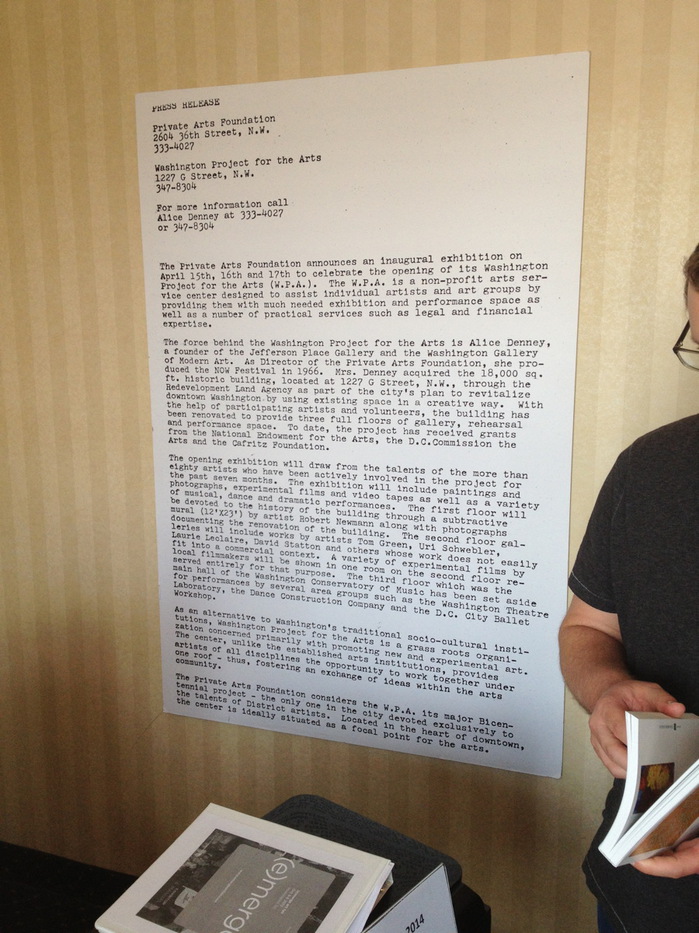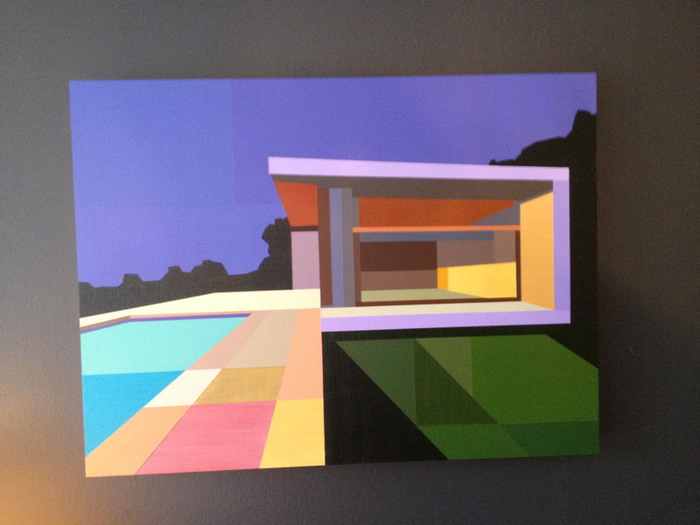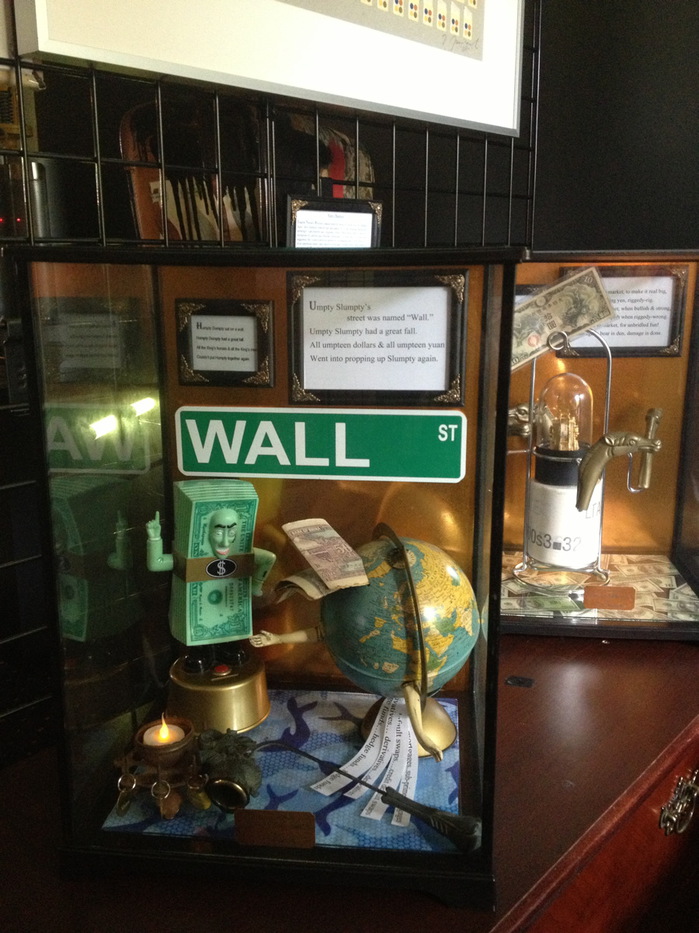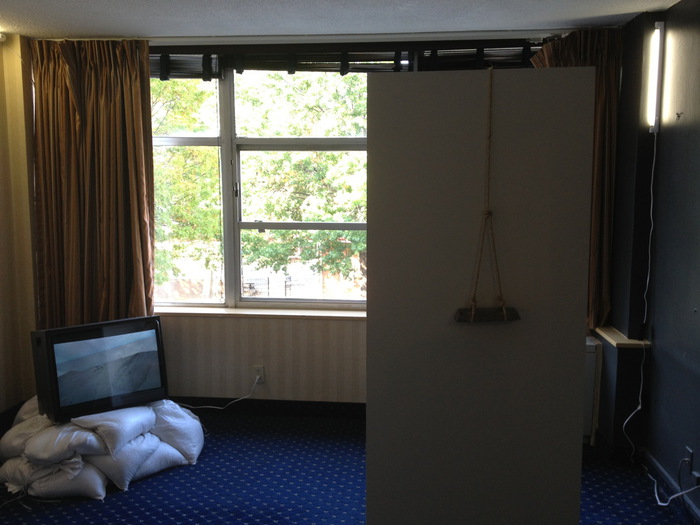The third edition of the (e)merge art fair was held this weekend at the Rubells' hotel in Washington DC. After not being sure whether I'd be in town, I was, and I went on Saturday afternoon. I'd say it was well-attended, but not crowded.
The fair was smaller than the first/only time I'd been in 2011, with one 32-room floor of exhibitors instead of 2.5. And some of this year's exhibitors took double/adjoining rooms. And in addition to a couple of DC galleries, there were local non-profits and agencies like Transformer Gallery, WPA, and DC's Arts & Humanities agency.
Despite trying to keep up with art making things, I knew almost none of the galleries or artists I saw. (E)merge's emphasis on emerging galleries showing emerging artists felt like a self-fulfilling and self-limiting parameter that makes for a tricky situation in which to buy--and sell--art. It's a set-up that appeals almost exclusively to collectors' impulse purchase reflex, not their investment aspirations, and definitely not their craving for glamor, luxury, status, or social theater.
On the other hand, there seemed to be significantly more artists in the fair's Artists Platform, self-representing artists, collaboratives, and artist-run galleries who were spread out around the hotel's ground floor, deck, and parking garage. They were mostly solid, engaging, and interesting. Baltimore and MICA were heavily represented, the Corcoran, much less so. I left wanting to merge (e)merge with Artomatic.
But enough of that armchair quarterbacking. Here's some of what I saw that stuck with me, in roughly chronological order. It's like a timeshifted liveblogging highlight reel of my (e)merge visit.
Lower Level:
Honestly, if the garage and pool are the best part, why not just have an art fair in a parking garage? Because no parking? Or is it horrible lighting, floors, leaking pipes, and ceiling heights?
First stop was Chronoecology Corps, a pair of time-traveling archeobotanists who had a couple of tables set up with samples of plant life, which they were preparing to take back to the remnants of humanity living underground in the ecologically wasted 23rd century.
They asked if I'd seen the strange, blue rectangle of water above, and were the people there participating in some sort of ritual. And I asked if a parking deck in SW DC was the best place to be hunting for untrammeled nature. And if the future was really so bad, why didn't the entire population evacuate to another time? [Limited power.] I asked if there was a Temporal Prime Directive in the 23rd century, and when they said they didn't know what that was, I suggested they go back to the mid-90s sometime and park themselves in front of UPN. Later another artist mentioned that the Chronoecologists were admirably remaining in character wherever they went, and we determined that if encountered again, we should ask them if they knew of Daniel Day-Lewis. [spoiler alert, the fair website & map says this spot was reserved by "Benjamin Andrew".]
Paul Shortt, "Legitimate Artist" was resting in his parking spot; normally he was performing, carrying his giant MFA diploma around the hotel. It was CNC-routed out of maple, so it weighs a ton, though it's probably not as burdensome as his student loan debt. We commiserated on his alma mater UIUC's refusal to take all of Harry Partch's crazy instruments when they were offered. He seemed caught off guard when I asked if Diploma was for sale, or maybe it was an edition. I would find this reaction several more times and, though it seemed paradoxical for an art fair, I decided to take it as a refreshing and encouraging sign; naiveté is not the best way to avoid art's object commodification problem, but it'll do in a pinch.
They were busy working it, so I did not get a chance to talk with the folks at Animals and Fire, but it looks very interesting. [I see they're involved in Benoit Izard's wrap-people-in-tape performance, part of the Washington Adhesive School, along with Mark Jenkins' tape babies and Wilmer Wilson's Post-it performances.] The Baltimore gallery sophiajacob had a table of congealed & melted soy oil, heated underneath with gallery lamps, by Chris LaVoie; digital tapestry/throws by Zoë Clark; and ceramic situations by Caitlin Cunningham.
Let's pick up the pace a bit:
DC's own Pleasant Plains Workshop had a nice, big, deep print of the cover of The Crier, a new homegrown local broadsheet. It's only $100 for an ed. of 5, but if you're too late and/or cheap, there are lesser, free editions of the paper itself at the shop.
One of the strongest showings of the whole fair was Print/Collect, a new print portfolio/publication produced by Baltimore artists. The current/first/proof-of-concept edition, curated by Jennifer Coster, includes prints by Colin Benjamin, John Bohl, James Bouché, Cindy Cheng, Graham Coreil-Allen, Chris Day, Andrew Liang, and Molly Colleen O'Connell, plus a separate catalogue with additional images and texts for each artist.
It's really polished, and it looks really great. At $200 for an edition of 125, it was the no-brainer score of the fair. The slick exhibition area featured work by portfolio artists, including these monotypes by Benjamin, from a larger project/series called Open Screen Flood.
O'Connell made this huge, antic, all-over ink on paper drawing of a, what, a multi-story amusement park?
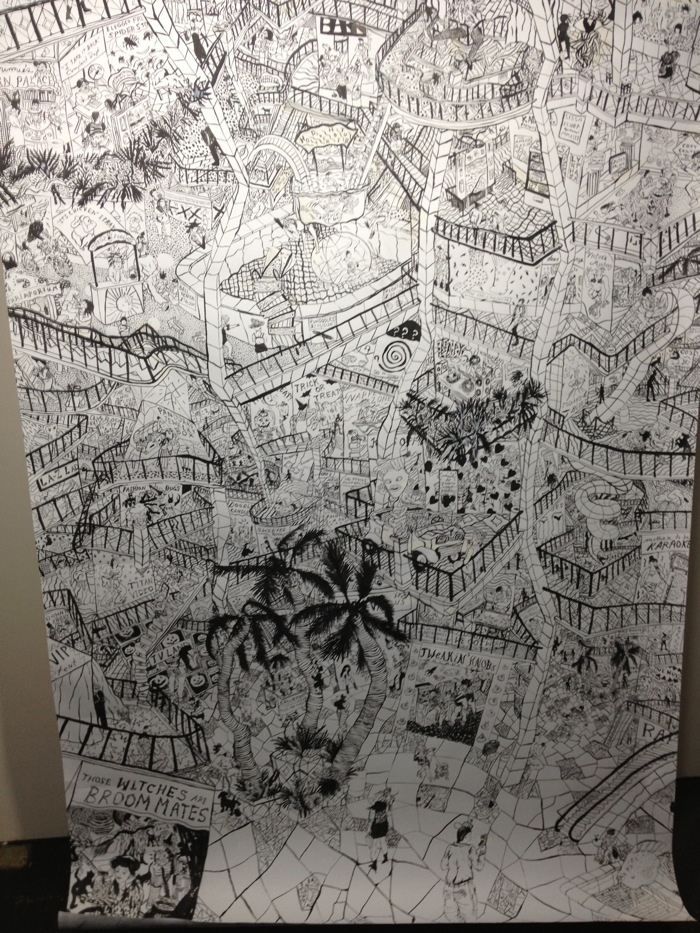
Bouché had this full-on painting/object, Structure No. 4, with cinderblocks, chain, and light fixtures, which he'd recently shown at Springsteen Gallery [Read BCP's review here.] I think those ceramic head and pedestal situations are Cheng's.
Dave Eassa, a recent MICA grad, had some big, textural narrative paintings, and these concrete- and found object columns, poured in forms in a way that preserves their haphazard creation process. Plus a head on top, screaming at the sky or something. Is there a professor in Baltimore telling people to "Do something, do something else ceramic, put a head on it."? Anyway, Dave was looking to make his money back on the truck. Hope he did.
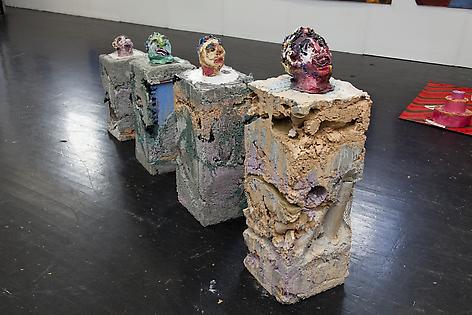
image via emerge art fair
DC photographer [his card says art worker] Thomas Petzwinkler had an impressive topographical photographical object, a photo taken from the base of a cliff that he'd gridded and extruded in a low-res 3D/pixelish way. Except it was on the ground, so the axes were twisted, and it read momentarily as an abstract contour map, but with a disorienting effect. It's the first he'd made of this kind, Petzwinkler explained, and he's working on the concept.
When I asked about how he was selling it, he wasn't ready to talk about it. Which struck me again, how, for some artists, the fair functioned as a promotion or engagement forum, not a place they'd really even contemplated selling their work. Or maybe it's more accurate to say contemplated their work selling. This is a situation ripe for glass half full/empty interpretation, if that's what you'd like to do.
Meanwhile, upstairs in the room-turned-Gallery-Platform spaces, the sell was a little harder. Washington Project for the Arts was moving local artist members' $50, 8x8-in works on paper at a fairly brisk clip. It is worth noting that the organization has stayed so true to its mission that they could post a giant copy of Alice Denney's original press release on the wall. If that was someone's archival project, please correct me.
London-based crisp paintings of mid-century modernist architecture by Andrew Burgess, above in a now-annoyingly crooked photo, as well as several cast acrylic framed mirrors from Ultra Violet's Self Portrait Series. Having known Isabelle for almost 20 years, I can say with confidence that not since the rainbow Mickey Mouse angels has any work captured the essence of her artistic practice like a baroque mirror self portrait.
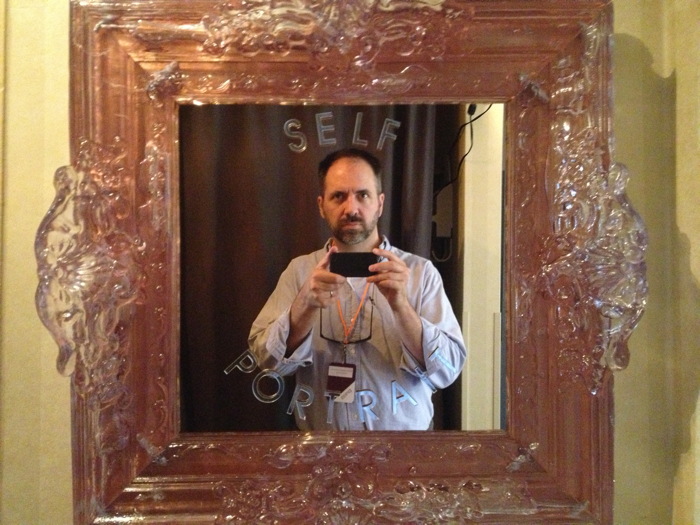
Some would say that an art fair, with its slick, friendly, commercial focus, is no place for controversial political art. Well, Charles Krause is not some. "The art of social and political change" is the very raison d'etre of the veteran foreign correspondent-turned-art dealer's DC gallery, Charles Krause/Reporting Fine Art.
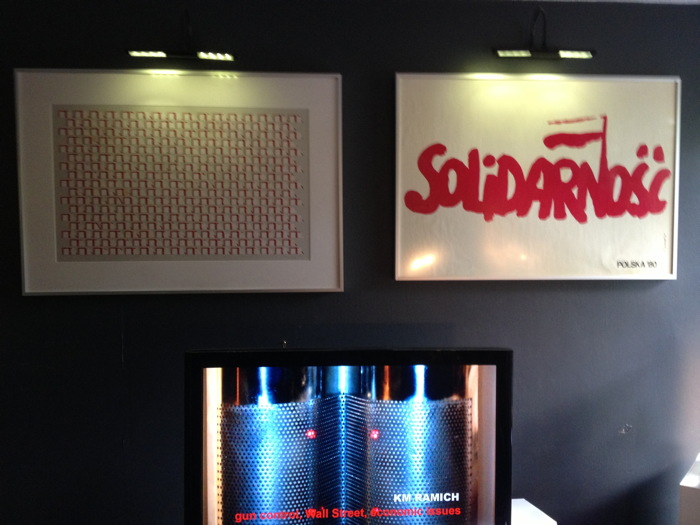
For (e)merge Krause presented works by Holocaust survivor Boris Lurie; the designer of Solidarity's original logo Jerzy Janiszewski, above; and positively incendiary dioramas from KM Ramich's "Pursery Rhymes" Series, which condemn the corruption of Wall Street's Fat Cats. That I don't recall any of the works containing either cat-related rhymes or cat figurines doesn't diminish their rhetorical effectiveness one bit.
Some galleries were full of complete and utter crap so bad you really have to wonder if the artists and dealers only got involved with art because they'd seen it on reality TV. And others were hawking their wares with the desperation and neediness that only underscored the economic precarity experienced by so much of the art world pyramid. You can almost imagine them deciding to go with (e)merge this year, with the hope of winning the Rubell lottery, that maybe Mera and Don would drop in and buy up their show, and--anyway, way too depressing, moving on.
There was some nice work by an artist from Harlem in Nomad Gallery's space, early 1960s Rauschenberg Combine-style objects, but my photo of the artist's statement was too blurry. And I don't see it on the gallery site. Maybe someone will remind me. [It was not Aimé Mpane.]
With three gallerinos in matching grey suits and [admittedly hideous hotel room] walls sheathed in cardboard, Brooklyn colabo Present Company's presentation was so ridiculously slick, I wondered if it was a performance, a critique of blue-chip galleries' fair booth aesthetic transformations as demonstrations of power and control. They showed the DMV hotshot Larry Cook, a 2013 GWU grad, whose Kehindesque All American portraits and video installations interrogate contemporary hip-hop culture's delivery on the dream Martin Luther King had. It made me fear our whole country was right there in that Lamborghini, going nowhere fast, as a crowd watches us turn endless donuts in the parking lot of the future.
Local contemporary micro-powerhouse Transformer went west to find their one-collaboration show, Strike Work by US English. James McAnally formed US English with his wife Brea, with whom he also runs The Luminary, a non-profit arts space in St Louis. Maybe given the depth of the McAnally's resume, it's not surprising that Strike Work was far and away the strongest presentation at (e)emerge. Named after a term for idealized, virtue- and ideology-driven overproduction, Strike Work was a "poetic" meditation on artistic labor and production. A video installation To Reform A Mountain showed a man filling sand bags at the foot of a giant salt mound, and then hauling them to the top to dump them.
It's like a one-man version of Francis Alys's 2002 project/video When Faith Moves A Mountain. Which, as I pointed out to James, had 500 guys working, and it was still futile. Oh me of little faith. James centered the project on the artist's agency, which implies that a key space for art's exchange is internal. Agency was the core of my favorite piece, Power Object, where a lead gallery pedestal weight was suspended on a rope, held in place by an artist on the other side of the wall. US English and Transformer had enlisted a roster of volunteers to take turns holding up the weight. They were free, James explained, to hold it however they liked. Again, this rankled me a bit. [Also, I think if you buy the work, you are obliged to pay whoever is sitting there holding it. It'll just be one more party hire; aren't all the bartenders and cater waiters artists already? I guess one should not get oneself started.]
In their statement for the show, US English writes, "The language of labor and economics has been swallowed into the art world." When it's actually the other way around. Even if it comes with a sustainable wage and benefits, is self-actualization sufficient, or even possible, to justify a certifiably-non-productive job? And is the freedom to exercise your labor any way you like as long as it delivers the demanded results technically freedom? Doesn't this all still have the effect of rationalizing and perpetuating an art system of inequitable exploitation? I'll tell you, I never imagined having this discussion at an art fair. But it made me want the work, in ways that the more direct appeals to form or aesthetics totally did not.
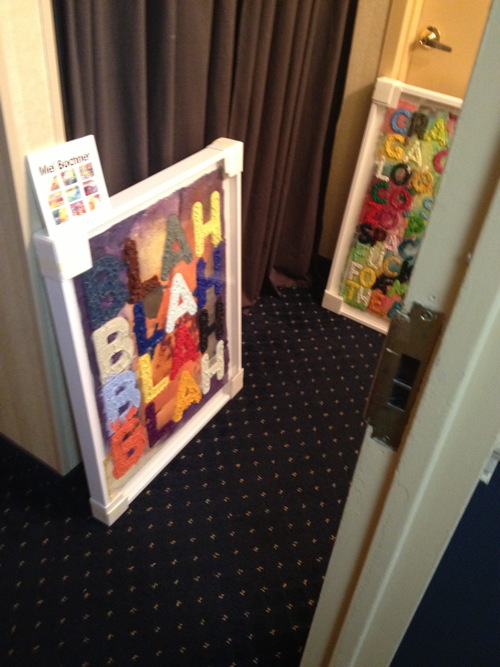
The last stop yielded a surprise: some very lush, very new BLAH paintings on handmade paper by the very much emerged Mel Bochner, which the folks at Rivoli-based Metroquadro had just pulled out of the closet to show a client. It was interesting after seeing so many unknown artists to suddenly have a flash of recognition; it made me think how strong the pull of the familiar can be. It also made me think of how the economics of art fairs are reliant on blue-chip price levels and margins. To cover their nut these Italian folks could sell five big, four-figure paintings by whomever, or find one Bochner buyer among the two dozen or so top collectors to attend the fair. In a way, it makes perfect sense. In every other way, though, it's completely nuts.

